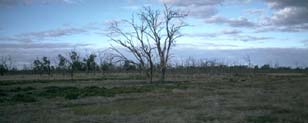Salinity Management in the North Central CMA
Salinity Groundwater Monitoring Reports | Planting Trees for Salinity Outcomes | Groundwater and Salinity Processes | Salinity Indicator Plants | North Central Key Bores | The Axe Creek Salinity Study
Salinity Groundwater Monitoring Update for the Campaspe Catchment | Salinity Provinces in the North Central CMA
Dryland salinity (external link) in the North Central region is a serious threat to agricultural productivity and biodiversity. Therefore, a multitude of planning and management activities are centred around this problem in the region, including groundwater monitoring for the Loddon Uplands, Loddon Dryland Plains, Campaspe Dryland Region and Avoca Dryland Region, and various community action plans. These include: Salinity Management Plans and associated activities (available in the ‘Water and Environmental Management’ section of the Goulburn-Murray Water website) (external link); community education for integrated management; implementation activities; integrated management plans; native vegetation conservation strategies for dryland catchments; Operation Undersow; land and water management control; surface water drainage investigations, and soil rehabilitation.
There are ten Salinity Management Regions overlapping the North Central region, for which Salinity Management Plans have been written. These include:
|  Salinity affected area near Kerang. |
Related Links
| Murray-Darling Basin Salinity Management Strategy. Information about the 15 year Basin Salinity Management Strategy (2001-2015) on the Murray Darling Basin Commission website (external link). Includes downloadable documents. |
| Murray-Darling Basin Salinity Audit (external link). Provides detailed predictions for all major river valleys in the Murray-Darling Basin for the next 20, 50 and 100 years. |
| Effectiveness of Current Farming Systems in the Control of Dryland Salinity. (external link) A downloadable CSIRO publication on the Murray Darling Basin Commission website. To view the information PDF requires the use of a PDF reader. This can be installed for free from the Adobe website (external link). |
| The Department of Agriculture, Fisheries and Forestry Australia website provides a range of documents related to Salinity Risk Management (external link) in Australia (including: the salinity problem; integrated salt risk characterisation and salinity risk management). |
| Information about salinity on the Australian Academy of Sciences website (external link). |
| The House of Representatives Standing Committee on Science and Innovation tabled its report on June 21st 2004 - entitled Science overcoming salinity: Coordinating and extending the science to address the nation's salinity problem (external link). A copy of the entire report is available for download on the Parliament of Australia House of Representatives website. |
| The Australian Government's Department of Agriculture, Fisheries and Forestry website provides a range of salinity information (external link) (including major programs and initiatives, research and development, salinity advice and salinity monitoring and assessment) as well as information about the National Dryland Salinity Program (external link) (including salinity mapping methods, Groundwater Flow Systems, desalinisation technologies and the Australian Dryland Salinity Assessment 2000). |


